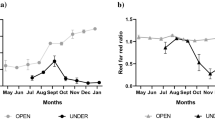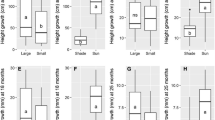Abstract
We asked how shade tree admixture affects cacao water use in agroforests. In Central Sulawesi, Indonesia, cacao and shade tree sap flux was monitored in a monoculture, in a stand with admixed Gliricidia trees and in a mixture with a multi-species tree assemblage, with both mixtures having similar canopy openness. A Jarvis type sap flux model suggested a distinct difference in sap flux response to changes in vapor pressure deficit and radiation among cacao trees in the individual cultivation systems. We argue that differences originate from stomatal control of transpiration in the monoculture and altered radiation conditions and a different degree of uncoupling of the VPD from the bulk atmosphere inside shaded stands. Probably due to high sap flux variability among trees, these differences however did not result in significantly altered average daily cacao water use rates which were 16 L day−1 in the multi-species assemblage and 22 L day−1 in the other plots. In shaded stands, water use of single cacao trees increased with decreasing canopy gap fraction in the overstory since shading enhanced vegetative growth of cacao fostering transpiration per unit ground area. Estimated transpiration rates of the cacao tree layer were further controlled by stem density and amounted to 1.2 mm day−1 in the monoculture, 2.2 mm day−1 for cacao in the cacao/Gliricidia stand, and 1.1 mm day−1 in the cacao/multi-species stand. The additional transpiration by the shade trees is estimated at 0.5 mm day−1 for the Gliricidia and 1 mm day−1 for the mixed-species cultivation system.


Similar content being viewed by others
References
Allen RG, Pereira LS, Raes D, Smith M (1998) Crop evapotranspiration: guidelines for computing crop requirements. irrigation and drainage paper no. 56, FAO, Rome, Italy
Amoah FM, Muertey BN, Oppong FK, Baidoo-Addo K, Osein Bonsu K, Asamoah TEO (1995) Underplanting oil palm with cacao in Ghana. Agrofor Syst 30:289–299
Andrade JL, Meinzer FC, Goldstein G, Holbrook NM, Cavelier J, Jackson P, Silvera K (1998) Regulation of water flux through trunks, branches, and leaves in trees of a lowland tropical forest. Oecologia 115:463–471
Balasimha D, Rajagopal V, Daniel EV, Nair RV, Bhagavan S (1988) Comparative drought tolerance of cacao accessions. J Tropical Agric 65:271–274
Baligar VC, Bunce JA, Machado RCR, Elson MK (2008) Photosynthetic photon flux density, carbon dioxide concentration, and vapour pressure deficit effects on photosynthesis in cacao seedlings. Photosynthetica 46:216–221
Bazzaz FA, Pickett STA (1980) Physiological ecology of tropical succession: a comparative review. Annu Rev Ecol Syst 11:287–310
Beer J (1987) Advantages, disadvantages and desirable characteristics of shade trees for coffee, cacao and tea. Agrofor Syst 5:3–14
Beer J, Muschler R, Kass D, Somarriba E (1998) Shade management in coffee and cacao plantations. Agrofor Syst 38:139–164
Bhagwat SA, Willis KJ, Birks HJB, Whittaker RJ (2008) Agroforestry: a refuge for tropical biodiversity? Trends Ecol Evol 23:261–267
Cannell MGR, van Noordwijk M, Ong CK (1996) The central hypothesis: trees must acquire resources that the crop would not otherwise acquire. Agrofor Syst 33:27–31
Carr MKV, Lockwood G (2011) The water relations and irrigation requirements of cocoa (Theobroma cacao L.): a review. Exp Agric 47:653–676
Daymond AJ, Tricker PJ, Hadley P (2011) Genotypic variation in photosynthesis in cacao is correlated with stomatal conductance and leaf nitrogen. Biologia Plantarum 55(1):99–104
Dierick D, Hölscher D (2009) Species-specific tree water use characteristics in reforestation stands in the Philippines. Agric For Meteorol 149:1317–1326
Dierick D, Kunert N, Köhler M, Schwendenmann L, Hölscher D (2010) Comparison of tree water use characteristics in reforestation and agroforestry stands across the tropics. In: Tscharntke T, Leuschner C, Veldkamp E, Faust H, Guhardja E, Bidin A (eds) Tropical Rainforests and Agroforests under Global Change. Springer, Berlin
Granier A (1987) Evaluation of transpiration in a Douglas-fir stand by means of sap flow measurements. Tree Physiol 3:309–320
Hernandez AP, Cock JH, El-Sharkawy MA (1989) The responses of leaf gas exchange and stomatal conductance to air humidity in shade-grown coffee, tea and cacao plants as compared with sunflower. Revista Brasileira de Fisiologia Vegetal 1:155–161
INRA (2007) French National Institute for Agricultural Research, Avignon, France. http://www.avignon.inra.fr/can eye. Accessed 18 Sept 2008
Isaac ME, Timmer VR, Quashie-Sam SJ (2007) Shade tree effects in an 8-year-old cocoa agroforestry system: biomass and nutrient diagnosis of theobroma cacao by vector analysis. Nutr Cycl Agroecosyst 78:155–165
Jarvis PG (1976) The interpretation of variations in leaf water potential and stomatal conductance found in canopies in the field. philosophical transactions of the royal society of London. B 273:593–610
Köhler M, Dierick D, Schwendenmann L, Hölscher D (2009) Water use characteristics of cacao and Gliricidia trees in an agroforest in central Sulawesi, Indonesia. Ecohydrology 2:520–529
Köhler M, Schwendenmann L, Hölscher D (2010) Throughfall reduction in a cacao agroforest: tree water use and soil water budgeting. Agric For Meteorol 150:1079–1089
Lal R, Regnier E, Eckert DJ, Edwards WM, Hammond R (1991) Expectations of cover crops for sustainable agriculture. In: Hargrove WL (ed) Cover crops for clean water. Soil and Water Conservation Society, Ankeny
Meinzer FC (1993) Stomatal control of transpiration. Trends Ecol Evol 8(8):289–294
Meinzer FC, Goldstein G, Andrade JL (2001) Regulation of water flux through tropical forest canopy trees: do universal rules apply? Tree Physiol 21:19–26
Meinzer FC, Bond BJ, Warren JM, Woodruff DR (2005) Does water transport scale universally with tree size? Funct Ecol 19:558–565
Mohd Razi I, Abd Halim H, Kamariah D, Mohd Noh J (1992) Growth, plant water relation and photosynthesis rate of young Theobroma cacao as influenced by water stress. Pertanika 15:93–97
Moser G, Leuschner C, Hertel D, Hölscher D, Köhler M, Leitner D, Michalzik B, Prihastanti E, Tjitrosemito S, Schwendenmann L (2010) Response of cocoa trees (Theobroma cacao) to a 13-month desiccation period in Sulawesi, Indonesia. Agrofor syst 79(2):171–187
O’Brien JJ, Oberbauer SF, Clark DB (2004) Whole tree xylem sap flow responses to multiple environmental variables in a wet tropical forest. Plant, Cell Environ 27:551–567
Omolaja SS, Aikpokpodion P, Oyedeji S, Vwioko DE (2009) Rainfall and temperature effects on flowering and pollen productions in cocoa. African Crop Sci J 17(1):41–48
Ong CK, Wilson J, Deans JD, Mulayta J, Raussen T, Wajja-Musukwe N (2002) Tree-crop interactions: manipulation of water use and root function. Agric Water Manag 53(1):171–186
Osei-Bonsu K, Opoku-Ameyaw K, Amoah FM, Oppong FK (2002) Cacao-coconut intercropping in Ghana: agronomic and economic perspectives. Agrofor Syst 55:1–8
Oyekale AS, Bolaji MB, Olowa OW (2009) The effects of climate change on cocoa production and vulnerability assessment in Nigeria. Agric J 4:77–85. doi: aj.2009.77.85
Purseglove JW (1968) Tropical crops, dictyledons 2. Longmans, London, p 719
Schroth G, Harvey C (2007) Biodiversity conservation in cocoa production landscapes. Biodivers Conserv 16:2237–2244
Schwendenmann L, Veldkamp E, Moser G, Hölscher D, Köhler M, Clough Y, Anas I, Djajakirana G, Erasmi S, Hertel D, Leitner D, Leuschner C, Michalzik B, Propastin P, Tjoa A, Tscharntke T, van Straaten O (2010) Effects of an experimental drought on the functioning of a cacao agroforestry system, Sulawesi, Indonesia. Glob Change Biol 16(5):1515–1530
R Core Team (2012) R: a language and environment for statistical computing. R Foundation for Statistical Computing, Vienna, Austria. URL http://www.R-project.org. Accessed 20 May 2013
Tscharntke T, Clough Y, Bhagwat SA, Buchori D, Faust H, Hertel D, Hölscher D, Juhrbandt J, Kessler M, Perfecto I, Scherber C, Schroth G, Veldkamp E, Wanger TC (2011) Multifunctional shade-tree management in tropical agroforestry landscapes–a review. J Appl Ecol 48(3):619–629
van Kanten R, Vaast P (2006) Transpiration of arabica coffee and associated shade tree species in sub-optimal, low-altitude conditions of Costa Rica. Agrofor Syst 67:187–202
Verchot LV, van Noordwijk M, Kandji S, Tomich TP, Ong CK, Albrecht A, Mackensen J, Bantilan C, Anupama KV, Palm C (2007) Climate change: linking adaptation and mitigation through agroforestry. Mitig Adapt Strat Glob Change 12:901–918
Wullschleger SD, Hanson PJ, Tschaplinski TJ (1998) Whole plant water flux in understory red maple exposed to altered precipitation regimes. Tree Physiol 18:71–79
Zhang L, Dawes WR, Walker GR (1999) Predicting the effect of vegetation changes on catchment average water balance, technical report 99/12. Cooperative Research Centre For Catchment Hydrology, Australia
Acknowledgments
This project was supported by grants from the German Research Foundation (DFG projects ELUC PAK 569/1, HO 2119/5-1 and CRC 990, A02). We would like to thank Abdul Rauf (University of Tadulako, Palu) for administrative help and our field assistant Masrillihardi Potabuga for his valuable contribution in form of field labor and a daily smile and lightness of being. We also thank Mareike Roeder for the art work.
Author information
Authors and Affiliations
Corresponding author
Additional information
Michael Köhler and Andrea Hanf contributed equally to this work.
Rights and permissions
About this article
Cite this article
Köhler, M., Hanf, A., Barus, H. et al. Cacao trees under different shade tree shelter: effects on water use. Agroforest Syst 88, 63–73 (2014). https://doi.org/10.1007/s10457-013-9656-3
Received:
Accepted:
Published:
Issue Date:
DOI: https://doi.org/10.1007/s10457-013-9656-3




